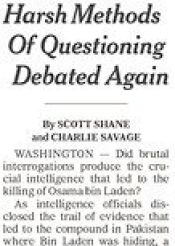Why does Boston Globe columnist Dan Shaughnessy keep saying (here and here) that the Celtics were 41-14 before the Kendrick Perkins trade? After all, they were 33-10 without him. No, I didn’t like the Perkins trade, either. But how the Celtics played while Perkins was rehabbing from knee surgery isn’t exactly relevant if the point you’re trying to make is that everything went to hell once he was traded. (Note: Italic section added for clarity.)
Month: May 2011
It looks like folks at the Boston Globe and the New York Times Co. have decided to get smart and take some of Boston Herald owner Pat Purcell’s money rather than try to put him out of business.
According to reports, the Globe is on the verge of a deal to print and distribute the Herald in the Boston area. It’s not the first time such an arrangement has been proposed, but it’s the first time the Globe has come this close to saying yes. A trusted Media Nation source credits Globe publisher Christopher Mayer for recognizing that the Herald isn’t going away and reversing the anti-Herald stance taken by previous publishers.
The unfortunate part of this is that the Herald would have to lay off its truck drivers. But on the trauma scale, that doesn’t approach Purcell’s decision a few years ago to shut down his presses and outsource much of the printing to a Wall Street Journal plant in Chicopee.
The Globe covers the story here, and the Herald here. The Associated Press quotes yours truly.
Boston Globe columnist Jeff Jacoby writes a fine comeuppance to those among his fellow conservatives who claim the killing of Osama bin Laden proves that torture works. Whether waterboarding helped produce the intelligence needed to track down bin Laden is irrelevant, Jacoby says, arguing:
Torture is unreliable, since people will often say anything — invent desperate fictions or diversions — to stop the pain or fear. That doesn’t mean waterboarding will never yield valuable information. Feeding a detainee into an industrial shredder, as Saddam Hussein’s torturers sometimes did, might yield valuable information too. But some techniques are forbidden not because they never work, not because they aren’t deserved, but because our very right to call ourselves decent human beings depends in part on our not doing them.
Jacoby also picks apart the disingenuous notion that waterboarding isn’t torture, citing — as have I and others — the execution of Japanese officers who waterboarded American prisoners of war.
William Taylor, the former Boston Globe publisher who died Sunday, was both lucky and good.
Lucky because his time as publisher coincided with an era of enormous prosperity in the newspaper industry. Good because he used that prosperity to transform the Globe into one of the best papers in the country. Under Taylor and the late editor Tom Winship, the Globe grew into a national-class paper with its own correspondents overseas and around the country.
For those who needed reminding, today’s obituary, by Bryan Marquard, explains why Taylor had to sell. With the paper on the verge of devolving to about 120 heirs, the only way Taylor could preserve the Globe’s legacy was to leave it in the hands of a good steward. He chose the New York Times Co., which paid an astounding $1.1 billion — half the Times Co.’s stock-market valuation at the time.
And if the Sulzbergers haven’t been quite the magnanimous owners Bill Taylor might have hoped for (especially when his second cousin Ben Taylor was sacked as publisher in 1999), they still have maintained the Globe’s quality to a far greater degree than a bottom-feeding chain like Gannett or a bankrupt behemoth like Tribune would have.
Bill Taylor’s death comes at a time when Ben Taylor and his cousin Steve, himself a former Globe executive, are seeking to return to some sort of ownership role as part of a group put together by local businessman Aaron Kushner.
The Taylor brand gives Kushner instant credibility — and it was Bill Taylor who was largely responsible for creating that brand.
Also: The Nieman Foundation pays tribute to Taylor.






